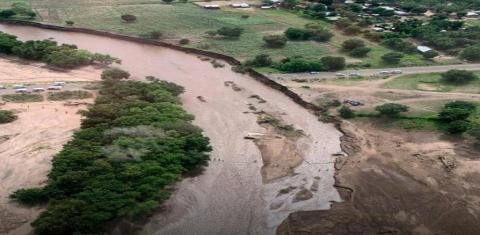Malawi embraces training for environment reporting
Submitted by fkakooza on

In March 2023, Malawi experienced one of the worst environment disasters when tropical cyclone Freddy hit the country. According to the 2023 Post-Disaster Needs Assessment Report, cyclone Freddy affected more than two million people, displacing 659,278, injuring 2,186 and killing 679 people. More than 500 hundred people were reported missing. The report attributes the majority of fatalities to landslides in the Southern Highlands. This is just one of the many disasters that Malawi has experienced in the last five years, and its effects placed Malawi in the top five countries worldwide most affected by extreme weather events, according to the Global Climate Risk Index.
During an interview with this reporter, Mathews Malata, the President of the Association of Environmental Journalists in Malawi (AEJ) noted that environmental degradation is due to multiple factors, including illegal logging of timber for charcoal and firewood, population growth, poverty, unsustainable mining, fishing and cash crop market systems. Moreover, there is lack of awareness of environmental protection, Malata added.
“It however turns out to be a call of emergency to media fraternity”, said James Chavula, the head of solutions journalism at The Nation Publications Limited and the Deputy General Secretary of the AEJ . “If the environment surrounding us is not safe, then we are not safe too,” he added.
It is therefore against this background that a number of associations and institutions in Malawi, including the AEJ, decided to train more journalists, environmental activists and researchers to advocate for environmental conservation and clean cooking and thus enhance environmental reporting.
Since 2011, the AEJ has been at the fore front of empowering environmental journalists throughout Malawi. The association conducts workshops and provides resources to media professionals to improve the reporting skills of local journalists, ensuring there is quality reach and viability of environment and science journalism across Malawi.
“AEJ offers grants to those interested in carrying out environmental projects, but also training opportunities to media professionals and independent journalists,” Mathews Malata, the President of the association says.
According to him, for a journalist to successfully cover the environment, he or she ought to exercise a high level of creativeness, professionalism and demonstrate competence. “A journalist should avoid being manipulated by politicians and this can only be achieved through training and being equipped with environmental science knowledge,” contends Malata.
The AEJ partners with public institutions like Ministry of Agriculture, Department of Disaster Management, media houses and institutions of higher learning to train practising journalists and journalism students.
Malawi University of Business and Applied Sciences (MUBAS) is one of the AEJ’s partners, and they have integrated environmental journalism in its Department of Journalism and Media Studies courses. According to Andrew Kaponya, a lecturer at the department and former media personnel for 15 years, the university has partnered with associations like the AEJ and others to deliver training on science and environment reporting.
“We have trained students in a generic manner that exposes them to any field of interest even when the department does not streamline environment studies,” Kaponya said.
Meanwhile, Lilongwe University of Agriculture and Natural Resources (LUANAR) in collaboration with Malawian environment activists also trains students to conduct and communicate scientific research on the environment. Under the Innovative Scholars’ Program, LUANAR in partnership with the Knight Center of Environmental Journalism and Michigan State University (MSU) trains students in environmental research and science reporting which has improved innovative research and academic projects.
Prescott Ntengezo, a journalism student at LUANAR noted that prior to the training, he, like many, considered climate as a boring field and would choose other fields over environment. “However, engaging in several trainings has motivated me to write environment stories and actually go for it,” he admits.
Since 2019, Journalism for Environment, Disability and Development (JFEDD) has trained journalists, using the solutions journalism approach. This approach encourages reporting that not only highlights problems but also showcases innovative ways of addressing them. JFEDD also creates awareness on environmental issues to Malawians. During the 2023-2024 agricultural season2 disaster by the El Nino phenomenon in Malawi, JFEDD was instrumental in providing critical information to public, ensuring that the voice of marginalized was not lost in the chaos.
In addition, Chavula observed that the available training opportunities with different institutions have been a pillar to advocate for environmental journalism and fighting for disappearing natural sources in Malawi.
“I urge all journalists to take up the watchdog role and fight for the well-being of Malawi, given that the so-called protectors have become the traitors of the environment,” Chavula said, and appreciated the training opportunities.
- 51 reads
